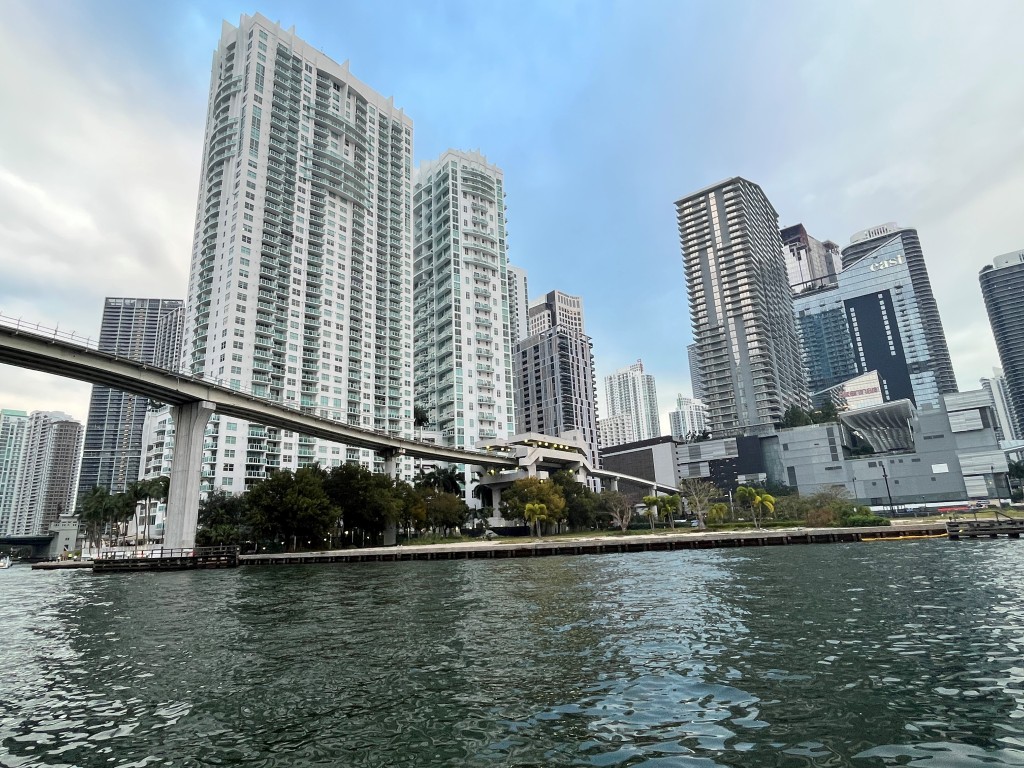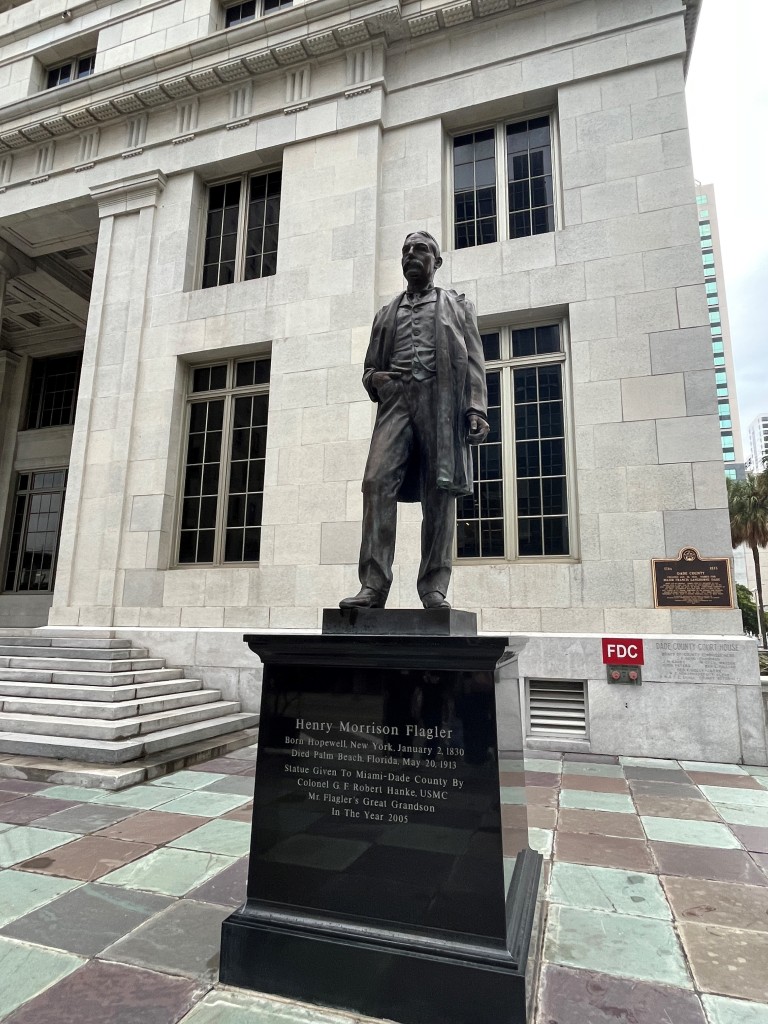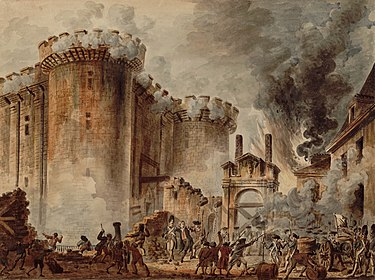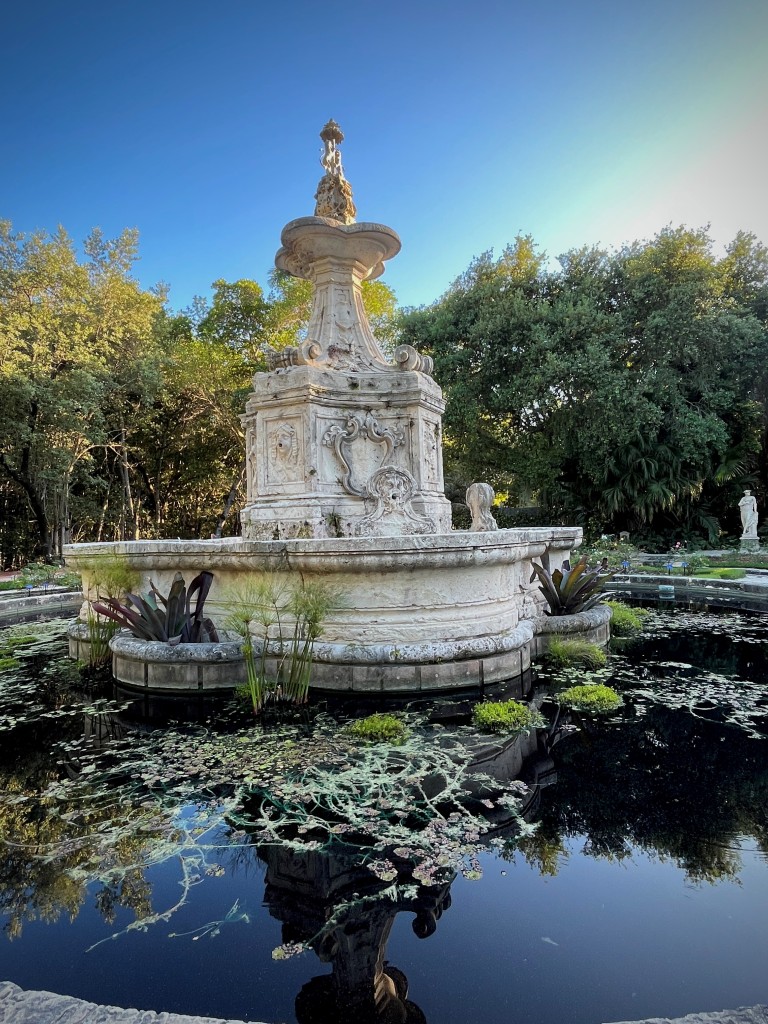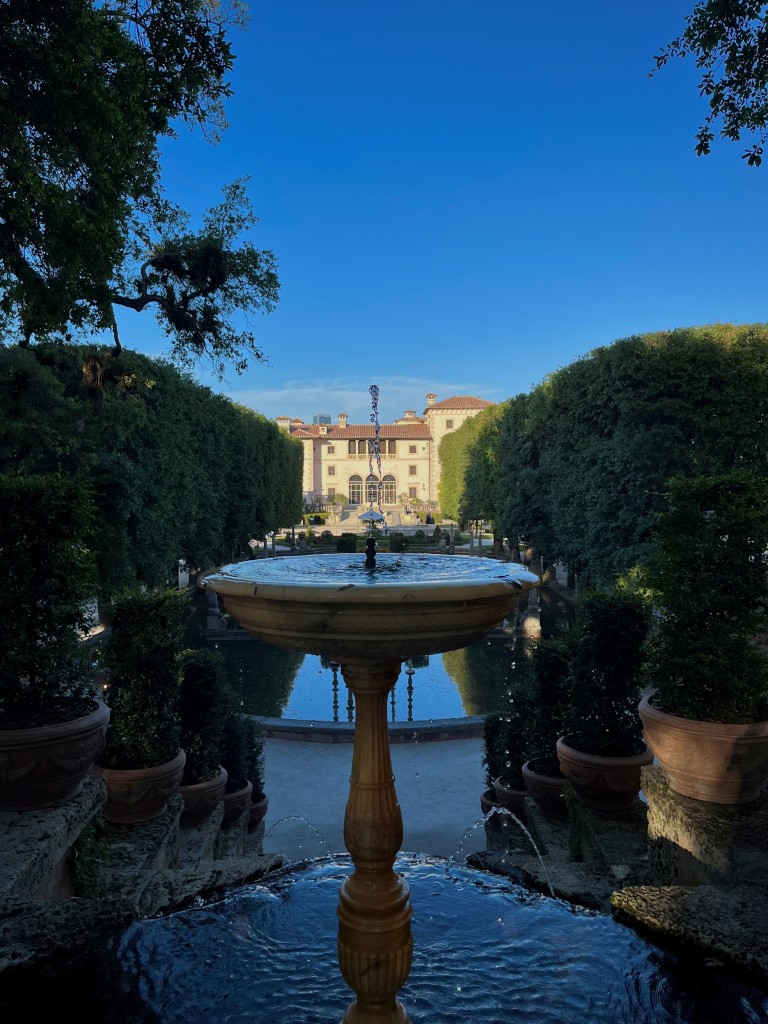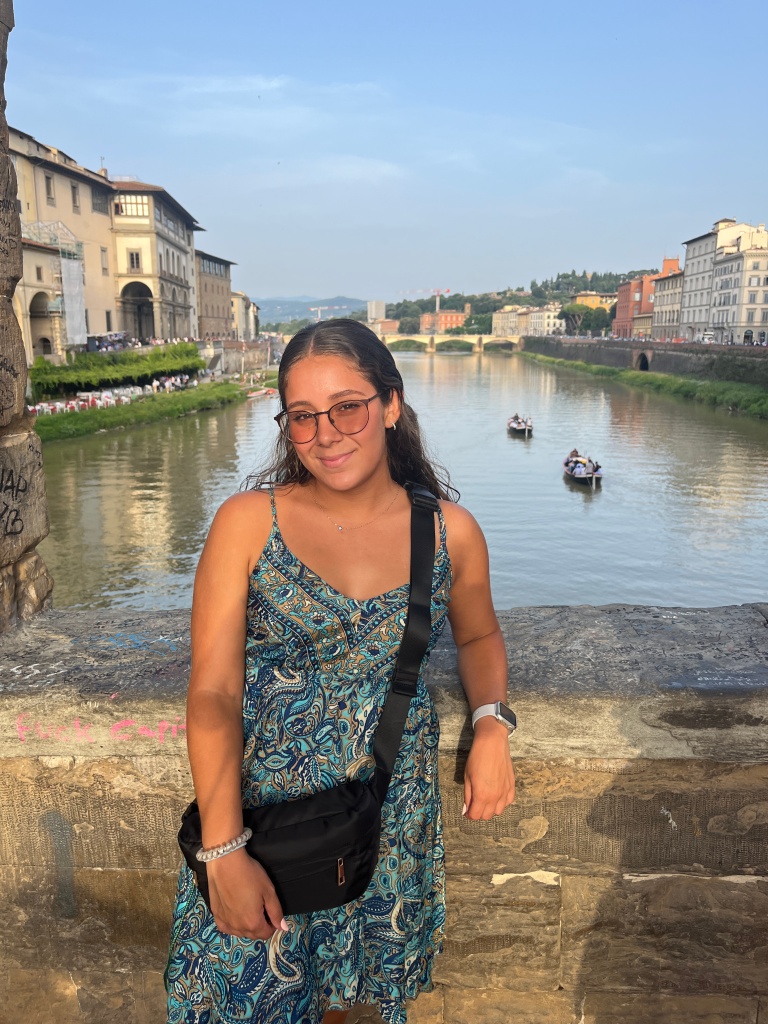
Amanda Ruiz-Diaz is a junior pursuing a degree in accounting at FIU. After graduating, she hopes to gain her CPA license and enter a career in forensic accounting. She was born in Miami but is a descendant of Cuban and Argentinian immigrants and is the first in her family to attend college. Amanda enjoys drawing, rollerblading, drinking coffee, and traveling.
France Encounter/Over Under Paris As Text
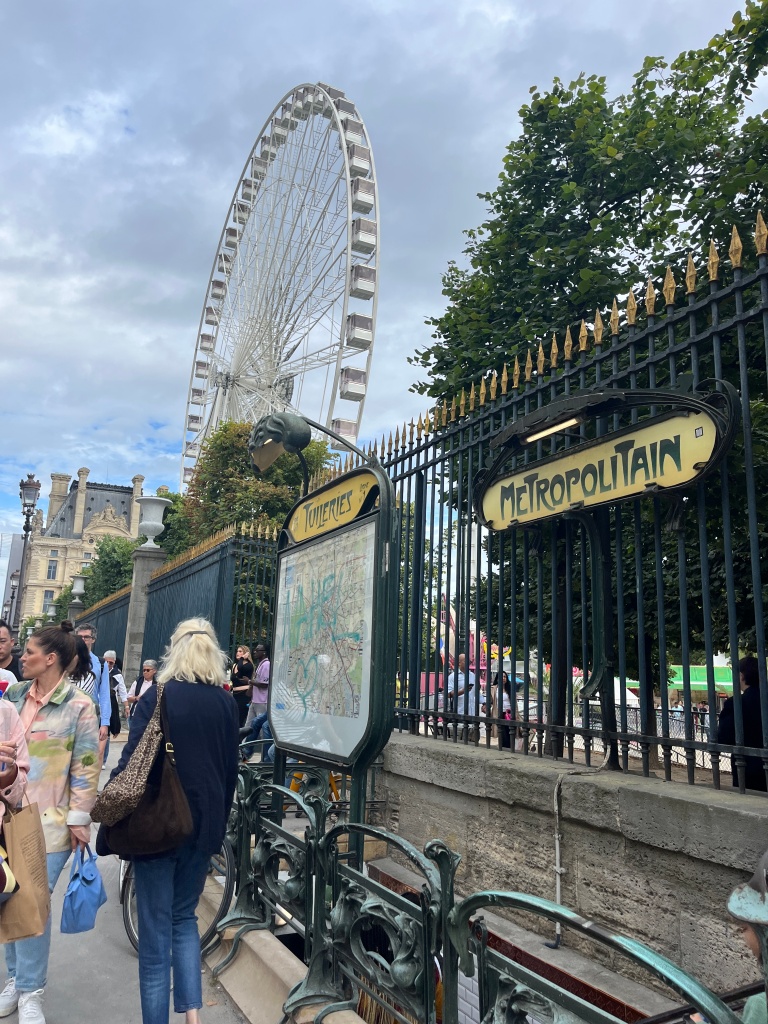
Photograph by Amanda Ruiz-Diaz 2023
Heart of Paris”, by Amanda Ruiz-Diaz of FIU at Tuileries Metro Station Paris, France, June 8th, 2023
The metro has shown to be extremely convenient on my mission to explore and uncover all Paris has to offer. Despite my not so friendly experience on the metro in Milan, Italy, I have become comfortable navigating the Paris metros and am one step closer to becoming one with the Parisian lifestyle. “The Parisian metro and art tell more than 100 years of a relationshipbetween the useful and the beautiful” (RATP, 2023). With the desire to incorporate art and history into almost every element of life, almost all Paris metro stations have their own themes. In contrast to subway systems in the United States, Parisians hoped that their metros were less of a means of transportation but a work of art.
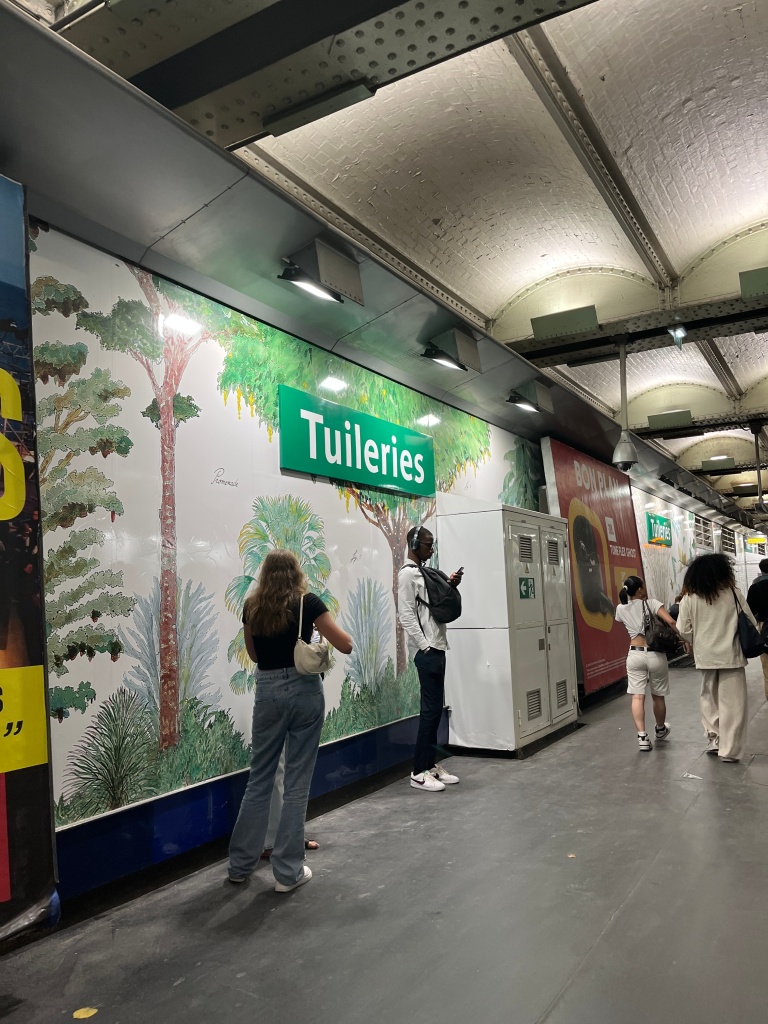
Photograph by Amanda Ruiz-Diaz 2023
I was not sure what to expect when I decided to stop at the Tuileries metro station, but in the end I feel that I discovered the heart of Paris. Getting off the train at Tuileries I quickly realized how different it was from other stops I had seen. First of all, unlike other stations, the signs displaying the station name have a green background while others have blue. Though each
metro station has its own theme, the Tuileries station, I believe, blows all the others out of water. Its walls were covered in a mural depicting trees and flowers, all illustrated and colored by hand, alluding to the enormous garden you may encounter above. Not only that but its luxurious appearance made a connection to the once royal palace on the grounds. The soft and fragile nature of the plants contrast the harsh and industrial nature of the subway, highlighting the human connection to nature. The mural was created by artist Cyprien Chapert and is entitled “Escape.” I was lucky enough to admire its beauty since it is there for only a limited time.
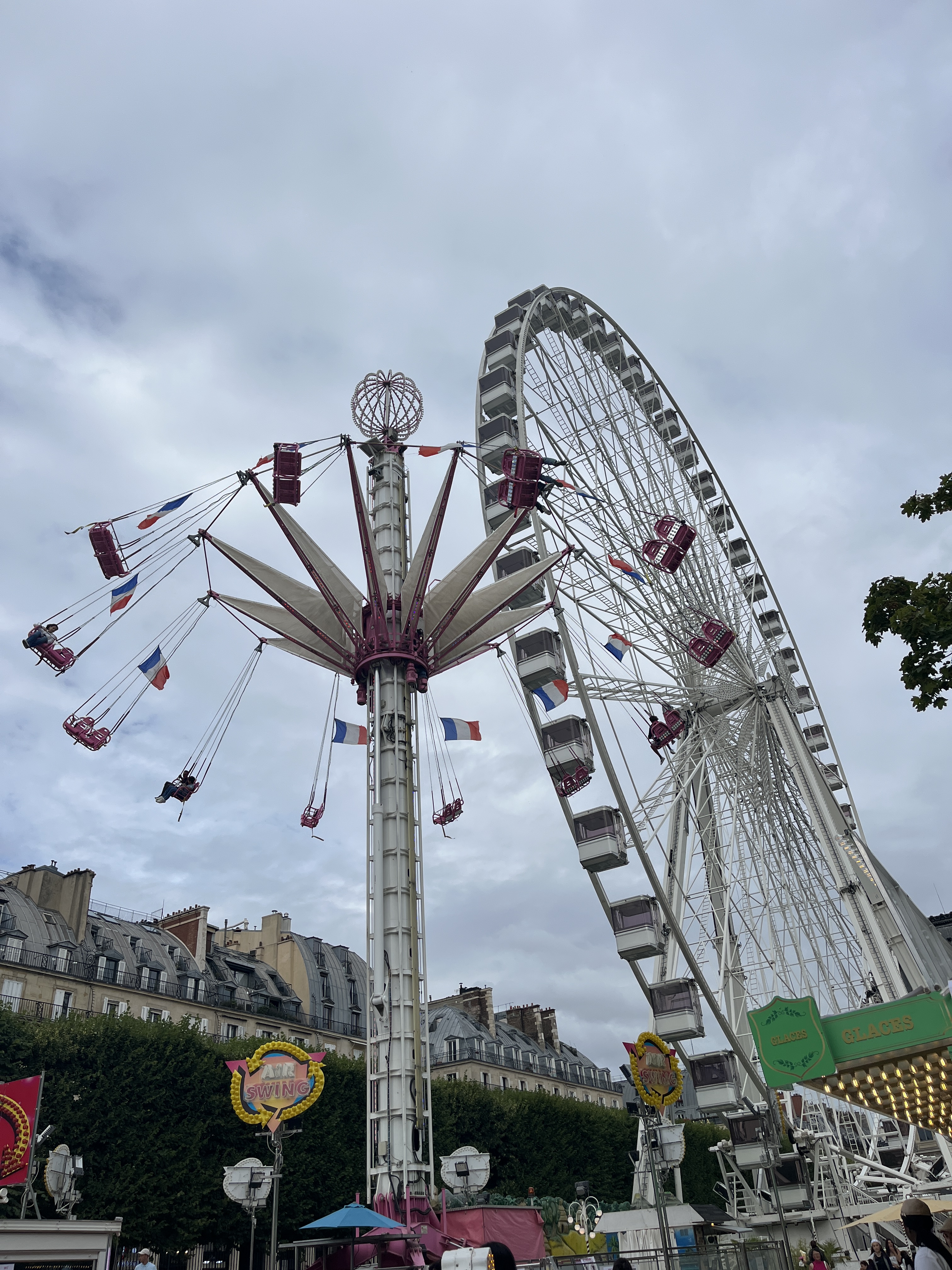
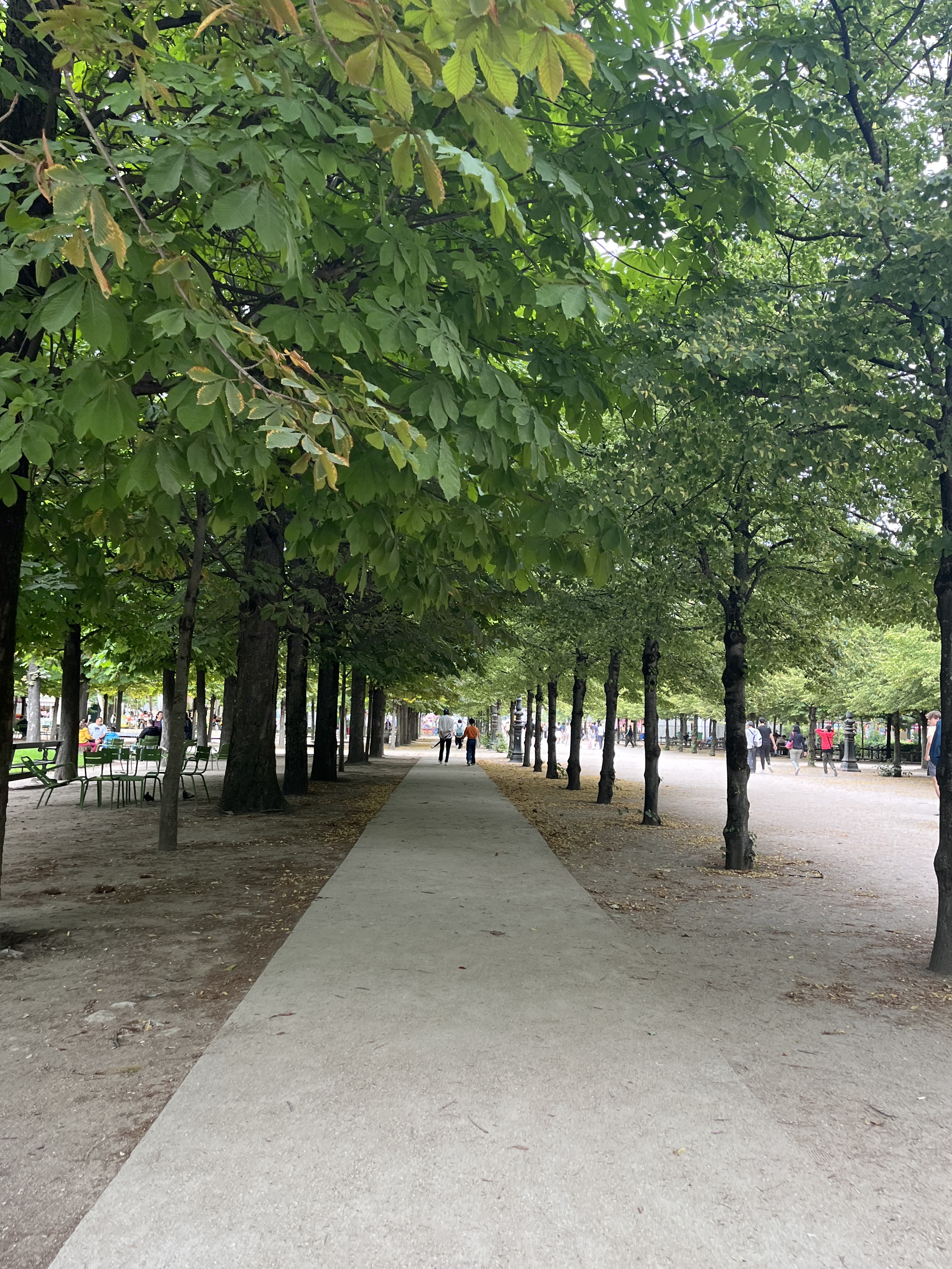

Photographs by Amanda Ruiz-Diaz 2023
Upon climbing the stairs to the streets above I was greeted by the sight of an enormous ferris wheel. Then bringing my gaze down to the ground I see a carnival filled with happy children and young couples. It was hard to believe that in such a famous and historical garden was a fair much like a miniature version of the Miami-Dade Youth Fair. Unlike our Youth Fair, the food stands at the carnival sold traditional french foods such as crepes, beignets, and gaufres. However, they sprinkled in foods of other cultures such as hotdogs, churros, and boba tea. Thus, it was similar to how Miami is a diverse blend of cultures all coming together to make something
unique.

Photograph by Amanda Ruiz-Diaz 2023
Walking into the Tuileries garden behind I watched people passing through with their designer clothes and handbags, accentuating how Paris is a wealthy city and considered the fashion capital of the world. Within the trees on the sides were people reading, smoking, playing pétanque, eating, and drinking with friends. This stood out to me as in Miami there is not much time to leisure such as the French do. On the patches of grass and flowers were easles for people to bring their canvases and paint in the gardens, once again emphasizing the french’s love for art. In such a large and busy city it warmed my soul seeing the locals spending time relaxing and socializing in the garden.
Dotted around the Tuileries garden was statues and monuments all with historical and artistic significance, making it a large outdoor museum right next to the Louvre. These statues were a blend of ancient and contemporary works contrasting each other, much different from the historical nature of the Louvre. From the middle of the garden you could spot popular landmarks such as the Luxor Obelisk lining up with the Arc de Triomphe and the Vendôme column on another end. It feels as if no matter where I am in Paris there was always a significant monument around the corner.

Photograph by Amanda Ruiz-Diaz 2023
Just outside the grounds of the garden you could see that the surrounding neighborhood was of a higher class. There were fancy restaurants and luxurious clothings stores on every street.
The buildings had the classic Haussmann style with their stone walls and mansard roofs. It was evident that it was one of the wealthier areas of Paris, where it may be more convenient to just to stroll through and window shop. However, spending time in the Tuileries garden is free.
RATP. (2023, May 31). Cyprien Chabert Habille La station Tuileries d’une œuvre appelée “échappée”. à demain (retour à l’accueil). https://www.ratp.fr/en/node/16280
Versailles As Text
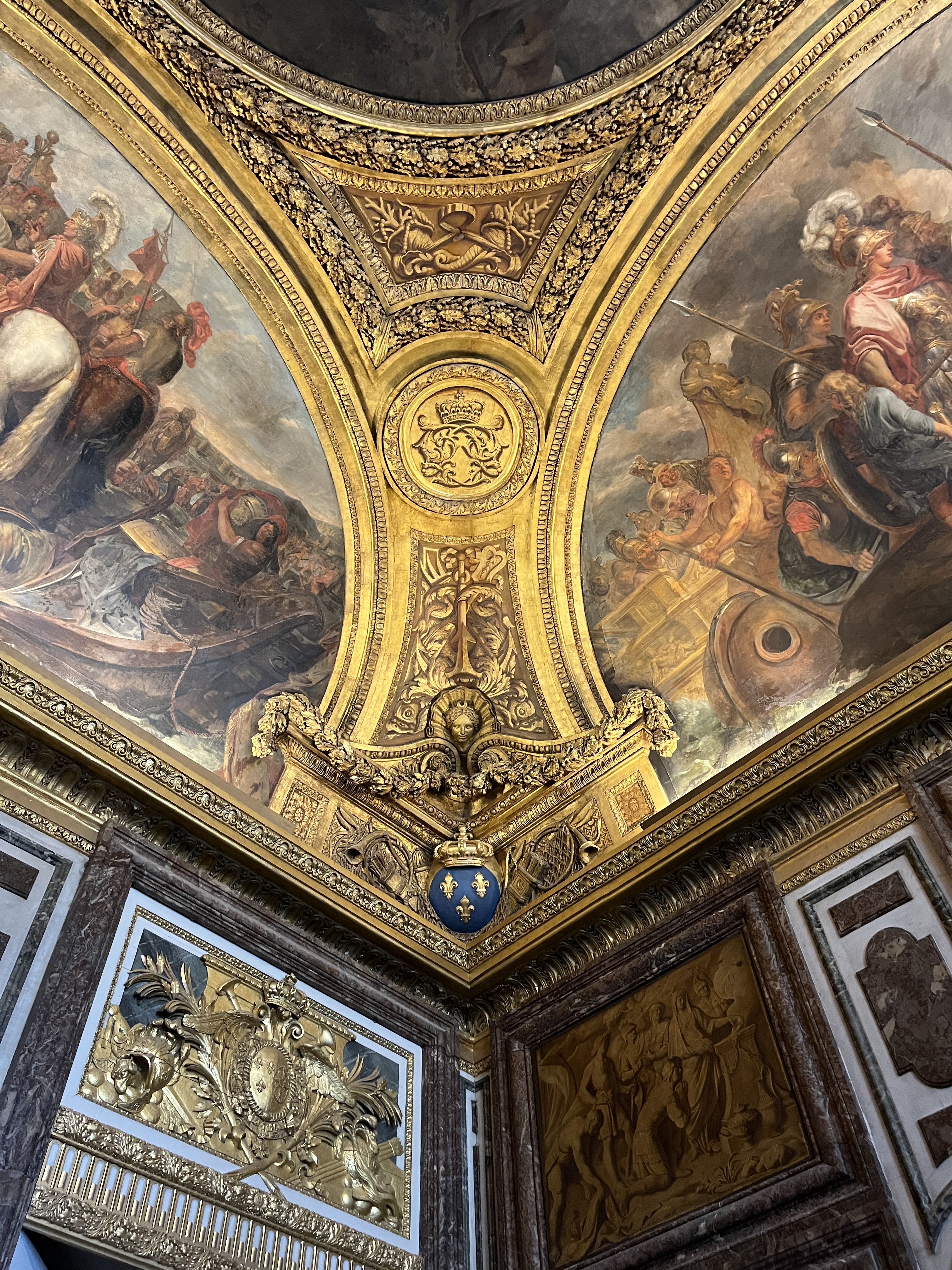
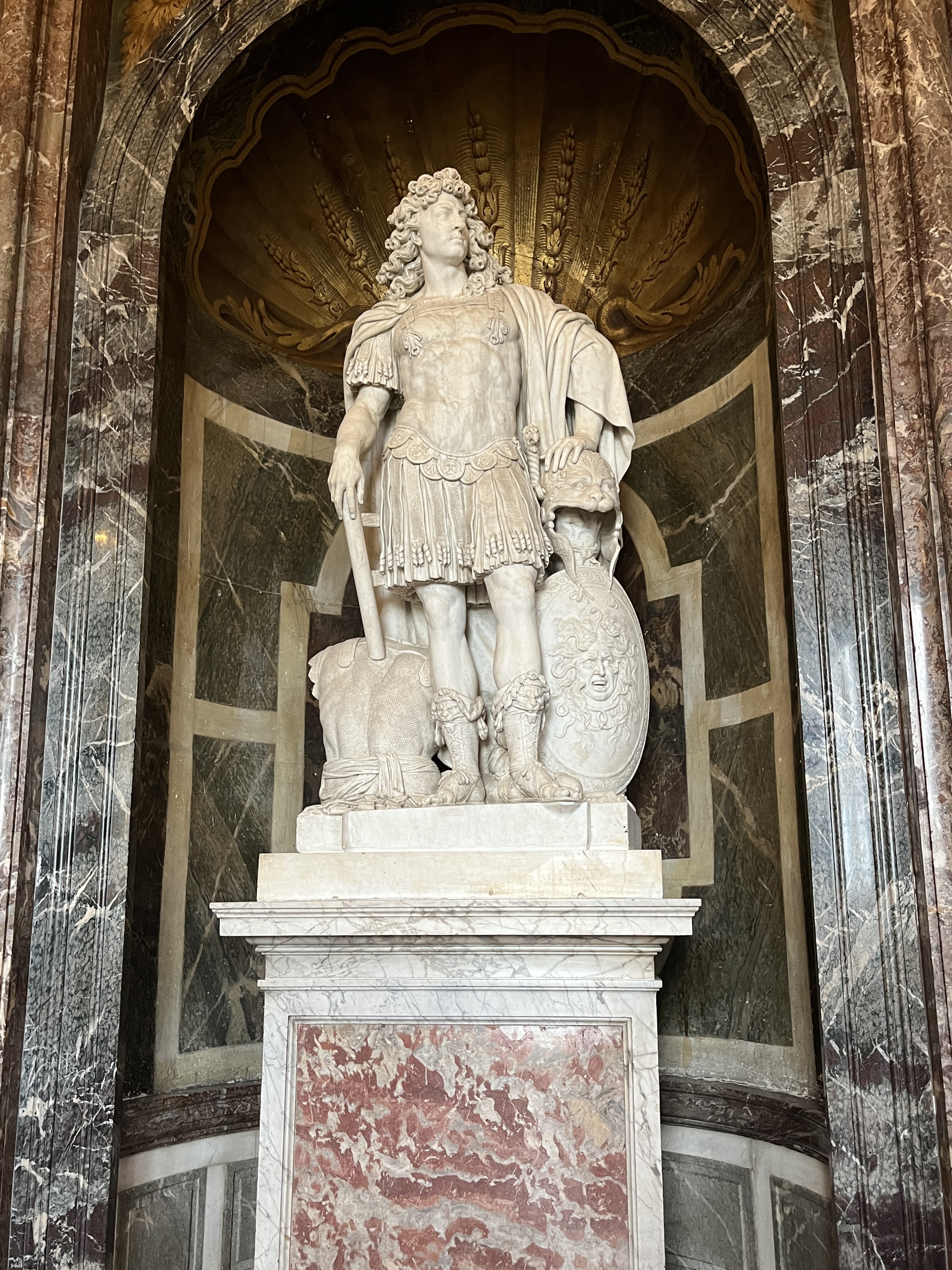
Photographs by Amanda Ruiz-Diaz, 2023
“Power and Perfection” by Amanda Ruiz-Diaz of FIU at The Palace of Versailles, France, July 13, 2023
The Versailles Palace is a wonderful abuse of power. In it’s dramatic rococo style, smothered in gold and intricate patterns leaving no wall empty, the place is a sight for sore eyes. The palace embodies the prime of French artistic achievement and craftsmanship. As soon as you enter you are reminded of the King Louis XIV’s mission for power and perfection. As you walk through every room, you see dozens of sculptures and paintings of Louis as different important historical/divine figures, a way for the king to demonstrate he should be worshipped. Some may say Louis XIV was a show off; probably overcompensating for something. But you could argue that he was a political genius. Being the intelligent leader that he was, he ensured that his palace sent this message: I am the sun king and everyone must respect my authority. Unlike those that came after, Louis XIV understood how to take control of a country, and although he left France in major debt, you still see the legacy he left behind hundreds of years later. Not only had he strengthened France’s power back during his rule, but he created a landmark that would be the face of France for eternity.
That is not to say that his great accomplishments did not come at the sacrifice of the people of France. One could say that Louis XIV was an overkill, with his extravagant vision for the expansion and transformation of Versailles, his dream of turning a hunting lodge into a home was becoming exceedingly expensive. It required boundless resources such as materials and labor, it was no wonder Louis spent about a quarter of France’s treasury on Versailles. Even after the completion of the palace, the upkeep of Versailles required significant funds. To maintain the palace were numerous servants and courtiers all whose salaries needed to be paid. Not to mention the constant lavish events hosted by the king in Versailles that also ate up France’s financial resources.
So how did the monarchy obtain the funds for this major endeavor? By taxing the lower class and borrowing large sums of money, thus leaving the poor even more poor and angry. The rich enjoyed luxurious lifestyles and parties while the rest of the population struggled to keep their head above water. Placing this financial burden on the lower classes while the nobility held significant privileges (such as avoiding taxes) and power heightened social inequality in France. Despite Louis XIV’s great efforts at maintaining the monarchy, the people of France felt resentment. Why should those with the least amount of wealth pay for the king’s expensive fantasies? Versailles was simply a constant reminder of the enormous economic disparity placing a burden on their lives. The increasing national debt influenced by war expenses and poor financial management by the monarchy only exacerbated the burden of the lower class.
Thus, Versailles is not only a representation of French art and culture, but it is also a symbol of neglect and abuse. It demonstrates the disconnection between the rich and poor. While we enjoy and marvel at its beauty we are reminded of those who paid the price for the legacy of King Louis XIV.
Paris As Text

Photograph by Amanda Ruiz-Diaz, 2023
“Stendhal Syndrome” by Amanda Ruiz-Diaz of FIU at Paris, France, July 16, 2023
I have to honestly state that before my first encounter with Paris, I had low expectations. This is mainly due to my limited knowledge of the city and my familiarity with Paris shock syndrome. It is stated that many people (especially from Japan) have such high expectations of Paris that when they discover the reality they become so disappointed they experience a series of physical and psychological symptoms. It is in some form a sort of “culture shock” stemmed from the disorientation one might feel when visiting a new country. Though hard to believe, Paris shock syndrome is real, and many tourists have to be treated every year for the severity of their symptoms. Thus, I did not want to get my hopes too high.
This is not to say that I was not excited to see Paris’ wonderful landmarks and monuments; experiencing climbing to the top of the Eiffel Tower, watching the tower sparkle at night, snapping a picture in front of the Mona Lisa in the Louvre, viewing original artworks by Van Gogh and Monet at the Orsay, walking through the hall of mirrors at Versailles. I wanted to experience the quintessential touristy parts of Paris, without thinking too much of the smaller details. However, after spending two weeks in the city of art and romance, it’s safe to say that I suffered from severe misjudgment.
In some way, I experienced the complete opposite of Paris shock syndrome— Stendhal syndrome. On my second day in Paris, I had the incredible opportunity to ride a dinner cruise down the seine river. It was right after our visit to the top of the Eiffel tower, essentially the first day I was able to fully experience Paris. That night sitting on the boat with a gourmet macaron on my plate, watching couples on the river bank dancing with live violin and piano playing “La Vie en rose,” and the Eiffel Tower sparkling in the distance, it felt so surreal I began to cry. It is hard to describe the feeling in my soul, but it truly felt like I transcended to a new world. I had never thought I could feel this way about a city, even after all the places I’ve traveled to.
Therefore, I could safely say I had nothing to worry about. Paris has wholeheartedly exceeded my expectations. The more time I spend in this enormous city, the more I fall in love with its history and culture.
Every day I explore a new part of the city, I dive deeper into the Parisian lifestyle: spending hours drinking wine at Champ-de-Mars, sharing a crêpe on the metro, shopping at Westfield, reading romance books in plazas, enjoying churros in the Tuileries garden, going to jazz clubs, and walking anywhere my legs can take me. There really is nothing else like it.
Despite the obvious large differences between Paris and Miami, both are incredible in their own ways. Unlike Miami, a city full of busy and hustle, Parisians take advantage of leisure time, which I deeply admire. In Paris, you see a large sense of community and a deep desire to spend time with those you care for, it is no wonder they call it the city of love. However, in both cities I notice an intense pride in culture; Miami’s diverse blend culminating into a large fiesta and Paris’ rich and intense love for art and history creating an enlightened and beautifully stubborn people.
It’s crazy to say that I haven’t felt homesick during these past two weeks almost 5,000 miles away from home, but Paris has had an incomprehensible affect on my mind and soul that has overcome any feelings of longing or pain.
Resistance As Text




Photographs by Amanda Ruiz-Diaz, 2023
“New Inspiration” by Amanda Ruiz-Diaz of FIU at Lyon, France, July 23, 2023
The past week has shown me that all I learned about World War II and the Holocaust when I was younger was only the surface of what I would uncover. I sat through lectures, watched movies, read Anne Frank’s diary, learned about Daniel’s Story, and dove into Night, but despite the amount of information I absorbed there was always a disconnect. Learning about one tragic story after another, this part of history remained a heavy topic in my consciousness. It was impossible to believe that there were people that wanted to erase an entire population to preserve an unrealistic ideal of the human race. That there were those cruel enough to imprison, torture, and exterminate innocent people, even children. What baffled me more was the fact that something like this was allowed to take place. How people sat idly by while millions were being massacred. However, our time in Lyon opened my eyes to the complexities that we fail to see behind these tragic events and all that is hidden behind “whitewashing” in today’s education and media.
In every major event in history, there always are those rare people who sacrifice themselves for a greater cause. They muster up all the courage and passion they have to fight against injustices they simply cannot let stand. In the past, I learned about those who survived and their “miracle” stories, they always tugged at the heartstrings, and their messages were always the same: hope in the face of adversity. It became difficult to go through the same process each time, extreme pain and sadness and then they lived happily ever after! But soon, I came to realize during this course that I could not recall any stories of the heroes; stories about boldness and fearlessness that leave you in awe at their valor. Just in the past week, I have learned more about resistance fighters than I did in my entire twenty years of life.
Hearing Laurent describe the bravery and selflessness of his mother, Denise (aka Miarka), was especially mind-blowing. She was one of the few that understood from the very beginning the horrible atrocities that were being committed. To learn that a girl at the age of sixteen, was already committing her first acts of rebellion by distributing anti-fascist materials and listening to news about the war on BBC radio that was banned by the Vichy government put into perspective the characteristics behind a resistance fighter. At the age of sixteen, I was focused on passing my AP courses and learning to drive, meanwhile, Denise was becoming heavily involved in worldly affairs and breaking the law to spread awareness. Even greater, Denise joined the resistance at the age of nineteen as a liaison, now officially becoming a secret agent of war. Her time in the resistance was a constant battle for her safety. She risked being recognized and arrested every day, but this did not stop her. After learning of the arrests of her family members, she entrenched herself in the resistance as a member of Franc-Tireur, a clandestine resistance newspaper. Her risky ventures caught up to her when she was arrested and sent to Montluc. Visiting her cell at the prison heightened my connection to her story and highlighted the cruelty she endured in her battle for freedom. Her story makes me recognize the privilege I have to be able to live my life without any restrictions on my speech and education (although it seems like as a country we are regressing).
Denise has inspired me to speak out on issues I would usually avoid in fear of being outcasted or ridiculed. Especially with the new controversial laws being introduced in Florida, it is apparent that the government is attempting to limit our rights and erase history. We are slowly watching our world turn into the dystopia described in Fahrenheit 451, where we will soon have to burn books banned by the government. It is important to stand up against these attempts on our freedoms just as those who fought in the resistance or else we will watch history repeat itself.
Denise Vernay-Jacob. Denise VERNAY-JACOB, Portrait de la résistance. (n.d.). https://www.fondationresistance.org/pages/rech_doc/?p=portraits&iIdPortrait=43
Normandy As Text


Photograph on the left taken by John William Bailly CC/4.0. Photograph on the right taken by Amanda Ruiz-Diaz CC/4.0.
“Honoring Laughter and Tears” by Amanda Ruiz-Diaz of FIU at Normandy, France, July 27, 2023
We go through our lives taking things for granted. Being able to go through our days not wondering whether it would be our last, we have the privilege of living our lives with this peace; war strips us of this privilege. In many ways we wish that there was never any war, we try to believe everything can be solved without violence, but in reality, that could never be true. There are times in history when war is a necessary solution, and World War II was one of those times. It was a time when innocent people were losing their lives for evil reasons, and others losing their lives to save them. George Whitson Rarey was one of the many who made the selfless sacrifice.
Born in Oklahoma on May 17, 1917, Rarey had bright aspirations for his future. He dreamed of being a cartoon artist and decided to pursue this dream in Greenwich Village New York. In 1941, while working for the Washington Star as a local cartoonist, he met his wife Betty Louise Hodge whom he called Betty Lou. The next year, at the age of 25, Rarey was drafted into the United States Army and soon he would begin preflight training in Maxwellfield Alabama. To Rarey, it is an ironic situation considering he does not have a driver’s license, and yet the Army thinks he would make a good flier. Despite this, he would prove to be an excellent pilot and service member as demonstrated by the oak leaf clusters on his medal.
Between learning his routines and classes he never put down his pen and paper, sketching cartoons of his daily life in the military, and sending them to his bride-to-be. The primary flight school in Ocala, Florida Rarey attended was one of the first to allow cadets to get married while training. Rarey married Betty Lou on June 13, 1942. Soon thereafter graduating from advanced flying school he was sent on an assignment in Massachusetts where as part of the 379th fighter squadron Rarey practiced in P-47 Thunderbolts.
On November 23, 1943, Rarey set sail for Britain on the Queen Elizabeth, leaving behind Betty Lou who was five months pregnant. Even in the cold England air, Rarey continued his drawings, but now diversifying his art, he painted cowlings during his free time. Eventually, about 30 aircraft in the squadron were covered in colorful nose art, bringing some happiness to his fellow servicemen. In a letter to Betty, Rarey wrote “…sort of gives personality to an otherwise pretty cold collection of machinery. I think it means quite a bit to the pilots, and the crews that keep the planes in shape get a kick out of them, too” (Rarey, 1944).
On March 22, 1944, Rarey receives a letter stating he is now a father to a baby boy named Damon. Upon finding out the news he celebrates with cigar rations and whiskey and honors his son by naming his P-47 “Damon’s Demon.” He tells Betty Lou how proud he is of his wife and how ecstatic he is to be a father.
“Tell him that he has the proudest, happiest, luckiest pop in the whole world”
(Rarey, 1944)
Just a few months later, Rarey and his friends decide to buy tickets to a ballet in London. The date for the event turned out to be June 6, 1944 — D-Day. Despite the atrocities that occurred during Operation Overlord, Rarey makes it out alive and continues to sketch and write letters to his wife Betty Lou.
An excerpt from a letter Rarey wrote to Betty Lou on June 26, 1944:
Lord, Betty Lou, it seems like an eternity since I’ve seen you—since last November in that fine little world of ours. I hated to leave it. I don’t care for this war —I want you and Damon and the life of our own choosing. I want to worry about the bills—ho! ho!—and mow the lawn and make kites and stuff for the Damon and his friends. I want to see you and kiss you every day of my life—I want to beef about your silly hats and tell you how lovely you are. I’ve got all these things to do and time’s awastin’—I ain’t getting any younger neither! So let’s get the war over—okay? “Until that happy day you know darned well, I can’t give you anything but love letters, baby.” Silly, isn’t it? You just keep that old light in your eyes and the one in the window and we’ll be fat. Ah, I love you, my sweet Betty Lou.
Love, Rarey
(Rarey, 1944)
On June 27, 1944, during a mission over central France, Rarey’s aircraft took a direct hit from flak causing it to explode, he dies at 27 having never met his son. In his honor, Damon publishes a book entitled “Laughter and Tears” filled with his fathers sketches and cartoons from during his service.

Although Rarey lived through one of the most difficult times in history, he always remained a bright light in the darkness. With his art, he brought color to the lives of his brothers in arms and remains an inspiration to his son he never had the opportunity to hold in his arms. Through his drawings and letters you are reminded that behind every cross at the Normandy American Cemetery, there is a soul buried there with hopes and dreams and a family suffering a deep loss. Although his story is devastating, it is important to honor his accomplishments and remember the life he gave up so that we could live the lives we have now.
The art of a fighter pilot. (1997, February 1). AIR FORCE Magazine.
“You mustn’t let it bother you too much.” AMERICAN HERITAGE. (2023, July 1). https://www.americanheritage.com/you-mustnt-let-it-bother-you-too-much
Pére Lachaise As Text
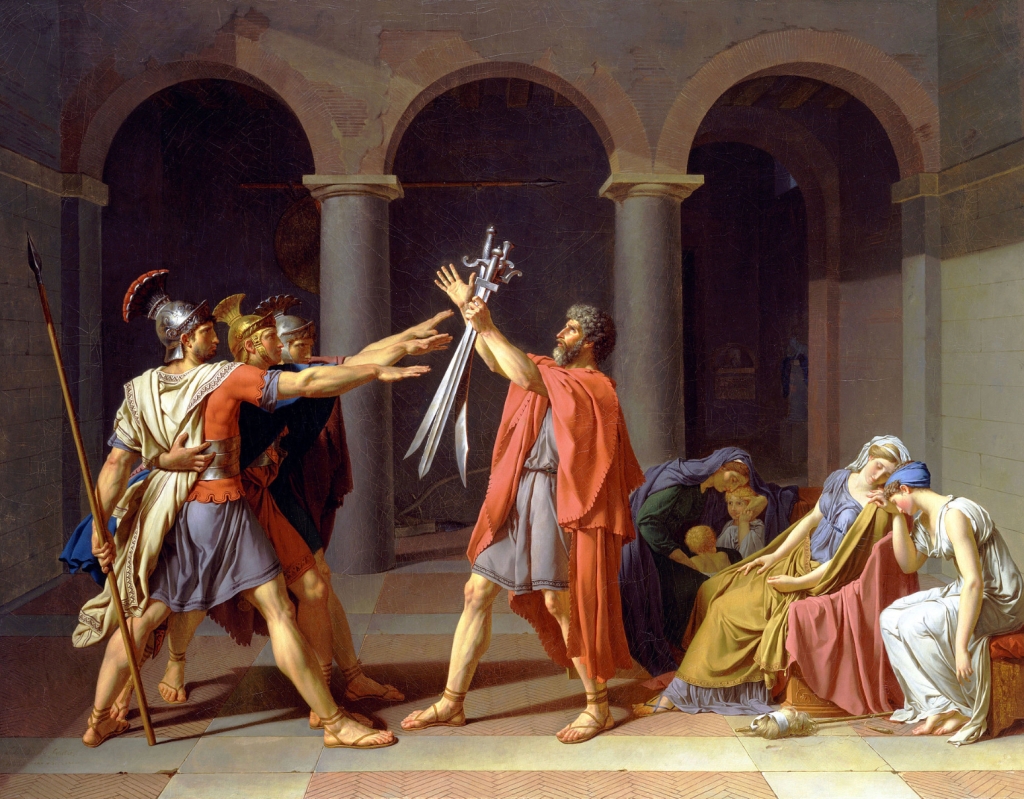
Oath of the Horatii by Jacques-Louis David.
“Artistic Patriot” by Amanda Ruiz-Diaz of FIU at Paris, France, July 28, 2023
In Paris 1748, Jacques-Louis David was born during the revival of antiquity. He was the son of a textile dealer who was killed in a duel, and a mother who came from a line of architects and builders. After the death of his father at nine years old, David was raised by two uncles on his mother’s side and with their strict support David was able to receive a traditional education.
His uncles wished to teach him as an architect but David insisted on becoming a painter. Because of his mother’s connections to François Boucher, he was placed under the guidance of Joseph-Marie Vien, the leading patron of the reaction against the Rococo style. Therefore, he was heavily pressured into the neoclassical movement. Soon, at eighteen years old, he was enrolled in the Royal Academy of Painting and Sculpture. David received widespread acclaim for his large-scale canvases conveying classical themes.
He was awarded the Prix de Rome in 1774 with his work Antiochus and Stratonice after four excruciating attempts and almost-suicide. Though he wanted to leave France because of his diastase for antiquity, he cultivated an interest for Neoclassical doctrines established in Italy.
David married Marguerite Charlotte Pecoul in 1782; a woman with significant influence since her father was an affluent supervisor of construction at the Louvre. This significantly assisted David’s career and from then on he advanced quickly. Andromache Mourning Hector led to his election into the Académie Royale and soon thereafter he was commissioned to paint Oath of the Horatii which was intended to be a symbolic story about loyalty to the state but David went on a different route and painted a scene of self-sacrifice and patriotism. Although not his original intention, this painting came to be known as a proclamation for an end to an incompetent aristocracy and a return to patriotic morals as it was in Rome.
Though much cannot be said about David’s pre-revolution political ideologies, David was a fierce supporter of the principles of the revolution. He believed in the principles of liberty, equality, and unity; the philosophies we see in the construction of our very own government. As an advocate for a democratic republican government, David believed in popular sovereignty and a government that would represent its citizens fairly. He strongly felt that the revolution was his opportunity to bring about this political and social transformation. In short time, he came to be known as an influential figure in the political history of France.
During the early phases of the revolution, David began to take more of a stance in politics. Being the activist he was, he became a member of the National Convention in time to vote for the beheading of Louis XVI and Marie Antoinette and for some time was the convention’s deputy for Paris. David was also associated with the Jacobin Club, a radical group of revolutionaries who fervently supported revolution initiatives such as the Reign of Terror. He was reported to have been involved in the delegation that arranged the Festival of the Supreme Being. David was also somewhat the artistic leader of the revolution, using his talents as propaganda to promote the revolution’s message. For instance, he painted revolutionary leaders such as in The Death of Marat which portrayed the deceased Jean-Paul Marat as a martyr of the revolution.
His political ideologies shifted when he became a court painter of Napoleon. Like many others at the time, he felt that Napoleon was a strong leader qualified to bring order to France and bringing revolutionary ideals into a centralized system. Not to mention that aligning himself with the new emperor would secure David’s position and status.
Although being the official painter of Napoleon, some of his work remained politically independent from the new regime as not all his works were Napoleonic propaganda. However, David’s close ties to the ruler would prove to be destructive to his reputation, and after Napoleon’s abdication, David was exiled from France.
Despite the changes in his political beliefs that I do not agree with, it is important to remember that political ideologies are not unchanging and thus David was just adapting to the environment of his country at the time. I do however, back his beliefs in liberty and in a government that represents the interest of its country. His strong passion for revolutionary change is something I admire, and his activism inspires me to stand up for change in my own country. Just as David, I strongly believe that the government should work to help its citizens and foster the enforcement of equal rights and opportunities. In addition, I recognize that art can be used as a powerful means of expression and advocacy as art says more than words will ever be able to.
National Gallery of Art. (n.d.). Jacques-Louis David. Artist Info. https://www.nga.gov/collection/artist-info.1212.html#biography
Encyclopædia Britannica, inc. (2023, June 7). Jacques-Louis David. Encyclopædia Britannica. https://www.britannica.com/biography/Jacques-Louis-David-French-painter
France As Text

Photograph of Amanda Ruiz-Diaz taken by Janessa Romero, 2023.
“Thank You For Everything” by Amanda Ruiz-Diaz of FIU at Paris, France, July 28, 2023
Thousands of miles away from home, a girl with a dream to explore the world was sitting in her dorm room in Paris. She had just spent over a month trekking around Europe for the first time all on her own, experiencing the adventure she had dreamed of since she could barely speak English. It was feat not only for a college student living off of scholarships, but for the eldest daughter of hispanic immigrants. Over the course of this journey, she discovered the wonderful parts of life that could not be taught in textbooks and is left with a profound sense of gratitude. Now she gets to take on a new world, her thoughts now clear because her eyes have finally opened.
I have the honor to say that I have experienced study abroad with John Bailly, a man full of wisdom and who seems to establish instant rapport with everyone he meets. He threw away the mask in front of my eyes and showed me how to look at history in a new light. He never failed to keep my brain locked in time, with constant knowledge pouring out of his mouth. I have can attribute most of my personal growth to his insightful lectures and the special spaces he decided to share with us.
The rest I associate with the people I got to know along the way. The connections I made with my peers have surpassed any others I have made during college. I got to establish bonds that would not be possible with the constraints of a classroom at FIU.
Not only can I say this was the most thrilling experience of my life but it was also the most enlightening challenge I have ever encountered. At the start of this class, I found out how little I knew about the world around me. I was never taught in such a unique way as I did during study abroad. We engaged in thought-provoking discourse and spoke about topics that most educators would avoid. We visited the places where history happened, and I was able to see up-close the things I would usually have to see on a computer screen.
I learned how privileged I am to be able to speak freely, practice religion freely, protest freely, and simply live the way I want to. I learned of those that did not have the same right. From the times of the Ancien Régime to the dictatorship of Hitler, we went into depth on the history of freedom and oppression in France. Under the absolute monarchy of the Old Regime, those who lacked wealth and status suffered while the nobility thrived with the King’s protection and aid. It was impossible to rise up the ranks and impossible to afford any kind of happiness if you were a commoner. Meanwhile, king Louis XIV was building one of the most beautiful palaces in the world, shaping french art and culture for years to come. Visiting Versailles felt like I was being pulled in two different directions, admiring its grandeur and beauty but trying to remember it came at the cost of the lower class of France. It reminded me of why we fought so hard for our system of government that provides equal opportunities and fair representation for all its citizens. Through this I realized that war is necessary. There are moments in history where injustices are so great that the only road to take includes violent rebellion. It was those who could barely afford bread for their families who had the courage to take a stand against the tyrannical ruler. I honored them on the 14th of July for their brave deeds as I sat and watched the fire works around the Eiffel Tower.
On another quest for freedom were those persecuted and marginalized during World War II. Despite all I was taught in preparatory school, I never understood the depth of what they went through. My education consisted of old books and movies that barely grazed the surface of the truth. Hearing Laurent Vernay and Claude Bloch share their stories presented me with a new understanding of the holocaust. In the past it was a subject difficult to get a grasp of, but I realized my brain was clogged with whitewashed fabrications of history. Visiting the cells where Laurent’s mother and Claude were imprisoned sent chills down my spine. Through pictures it’s impossible to get a grip on how small and demoralizing these cells are. It’s then when I saw the full picture. All those lives lost in Normandy were fighting for those locked behind bars with nothing but a rag and bucket, for those thinking they are about to take a shower at Auschwitz, for the orphans who were taken from their safe haven.
I realized what it means to be a hero. A hero advocates for those without a voice and confronts injustices in their society. They stand up to oppressors and ensure that the truth is never hidden. They risk their safety for something that is much greater than them. Without the unwavering devotion of people like Jean Moulin, Denise Jacob, and George Rarey, the evils in this world would prevail. Thus I have now a deeper gratitude for those who made the sacrifice during World War II.
As I near the end of my stay in Paris, I reflect on my newfound awareness. Never did I think one class could impact my life this tremendously. I laughed and I cried, but all-throughout I felt the shift in my soul. I leave with the anticipation of seeing the ones I miss paired with a wave of sadness for knowing I have to say goodbye to such a wonderful place. I will always hold this experience in a special part of my heart.
Au revoir France



